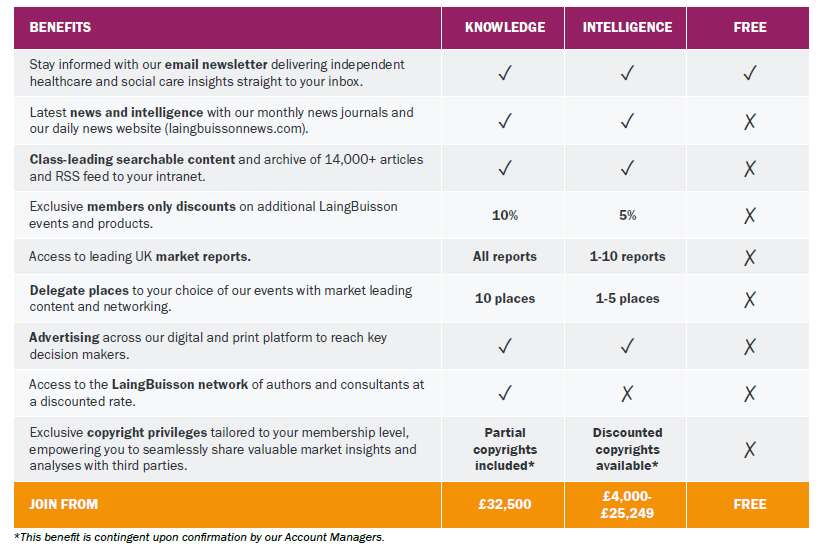Older people forced to pay nearly 20% more for their care, as fees skyrocket over the last two years
Care home fees have spiralled over the last two years for people requiring a bed in a residential care or nursing home, with some individuals likely to be paying up to 20% more in 2023/24 than they would have done in 2021/22, reports LaingBuisson’s latest edition of Care Homes for Older People.
- The average weekly fee for a residential care home bed has grown to £949 per week in 2023/24, up 19% from 2021/22, whilst the average weekly fee for a nursing home bed is now £1,267 (2023/24), up 18% on 2021/22.(1)
Fee uplifts are likely to reflect wider inflationary pressures on care home providers, such as the surge in energy prices following the war in Ukraine and successive National Living Wage uplifts that have been well over the general rate of pay inflation.
There is a significant disparity between the amount local authorities and private individuals pay for care, which is likely to exacerbate fears that older people are effectively subsidising the cost of care paid by local authorities who use their greater bargaining power to drive down fee rates for public-pay clients. The average weekly fee paid by councils for nursing care (2023/24) is estimated to be £1,146, whilst private-pay clients are charged an estimated £1,409 on average (£263 more). The difference is even higher in residential care, at £308 more for private-pay clients.
Care home fee levels vary across the country, with those in the north and the midlands paying substantially less for care than those in the south and London. The North East has the lowest average weekly fee for nursing care at £1,073, and the North West has the lowest average residential care fee, at £799 per week. The most expensive fees can be found in the South East, where people may find themselves paying £1,152 per week on average for residential care, and £1,457 per week on average for nursing care.
The reason why care home fees vary so much across the country is not just pay rates and property costs. These are certainly higher in affluent parts of the country, but it is not the whole story. Analysis by LaingBuisson of the results of the national Department of Health and Social Care mandated ‘Fair Cost of Care’ exercise carried in 2022 found that all care home cost lines are higher in affluent areas and lower in non-affluent areas, including spending on food, for example.
Most important of all, staffing levels (numbers of hours per resident per week) are higher in affluent areas than non-affluent areas. This can most plausibly be explained by care home providers in less affluent areas flexing all costs down to make their businesses viable when catering for a high proportion of local authority funded residents at relatively low fee rates. At the other end of the spectrum, providers flex all of their costs upwards to meet the preferences of a client profile dominated by private payers.
As the general election approaches, both the Conservative and Labour parties have seemingly backed away from tackling social care reform – presumably mindful of the so-called ‘dementia tax’ that had such a consequential impact on Theresa May in the 2017 general election.
There is increasing scepticism from sector stakeholders that the planned implementation of Clause 18(3) of the Care Act (due in October 2025) will ever come into force. This will be good news for providers, who may have been forced to offer care to private individuals at the lower local authority arranged rates, but with significant reforms seemingly off the table in the next parliament, there is little to suggest that older people who do not qualify for fully-funded local authority care will not have to bear the brunt of rising care home fees in the near future, with little alternative options available.
William Laing, report author and founder of LaingBuisson, said:
“Whilst it is no surprise that people required to dip into their savings to pay for their care will look at these increases and wonder how they can be justified, it must be remembered that staffing is by far the most expensive of operating a care home – accounting for around 70% of costs – and so the entirely necessary uplifts to the National Living Wage are having a significant impact on providers. Set alongside inflationary pressure leading to surging costs for all businesses, it is no surprise to see prices rising across the country.
“The hidden story is that those paying for their own care are effectively subsidising the cost of care paid for by local authorities. Using their larger purchasing power, local authorities can drive prices down in negotiation, but this may have resulted in providers being forced to charge more elsewhere. With social care reform a topic that neither the Conservatives nor Labour Party seemingly wants to tackle ahead of a general election, it appears likely that more and more people will be forced into meeting the cost of care from their savings.”







